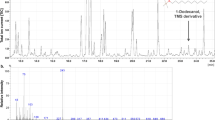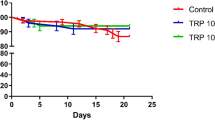Abstract
The bacteria Xenorhabdus spp. are entomopathogenic symbionts that can produce several toxic proteins that interfere with the immune system of insects. Recently, we purified the insecticidal protein XeGroEL from Xenorhabdus ehlersii and discovered that injection of XeGroEL into larvae of Galleria mellonella triggers strong immune responses. In this study, we determined the level of induction of several immune-responsive proteins that were secreted into the hemolymph using comparative proteomic analyses of hemolymph proteins from XeGroEL-challenged larvae. Additionally, quantitative real-time reverse transcription-PCR analyses demonstrated increased transcriptional rates of immune-related genes at 5 h post-challenge with purified XeGroEL. Our results help to understand anti-microbial immune responses in G. mellonella, suggesting that the immune system recognizes exogenous proteins and pathogen-associated molecular patterns.


Similar content being viewed by others
References
Altincicek B, Linder M, Linder D, Preissner KT, Vilcinskas A (2007) Microbial metalloproteinases mediate sensing of invading pathogens and activate innate immune responses in the Lepidopteran model host Galleria mellonella. Infect Immun 75:175–183
Bergin D, Murphy L, Keenan J, Clynes M, Kavanagh K (2006) Pre-exposure to yeast protects larvae of Galleria mellonella from a subsequent lethal infection by Candida albicans and is mediated by the increased expression of antimicrobial peptides. Microb Infect 8:2105–2112
Bode HB (2009) Entomopathogenic bacteria as a source of secondary metabolites. Curr Opin Chem Biol 13:224–230
Bouvaine S, Boonham N, Douglas AE (2011) Interactions between a luteovirus and the GroEL chaperonin protein of the symbiotic bacterium Buchnera aphidicola of aphids. J Gen Virol 92:1467–1474
Brown SE, Howard A, Kasprzak AB, Gordon KH, East PD (2009) A peptidomics study reveals the impressive antimicrobial peptide arsenal of the wax moth Galleria mellonella. Insect Biochem Mol Biol 39:792–800
Calderwood SK, Mambula SS, Gray PJ (2007) Extracellular heatshock proteins in cell signaling and immunity. Ann N Y Acad Sci 1113:28–39
Cytrynska M, Mak P, Zdybicka-Barabas A, Suder P, Jakubowicz T (2007) Purification and characterization of eight peptides from Galleria mellonella immune hemolymph. Peptides 28:533–546
Feldhaar H, Gross R (2008) Immune reactions of insects on bacterial pathogens and mutualists. Microb Infect 10:1082–1088
Forst S, Dowds B, Boemare N, Stackebrandt E (1997) Xenorhabdus and Photorhabdus spp.: bugs that kill bugs. Annu Rev Microbiol 51:47–72
Goodrich-Blair H (2007) They’ve got a ticket to ride: Xenorhabdus nematophila-Steinernema carpocapsae symbiosis. Curr Opin Microbiol 10:225–230
Hancock REW, Brown KL, Mookherjee N (2006) Host defence peptides from invertebrates—emerging antimicrobial strategies. Immunobiology 211:315–322
Hu C, Aksoy S (2006) Innate immune responses regulate trypanosome parasite infection of the tsetse fly Glossina morsitans morsitans. Mol Microbiol 60:1194–1204
Jiang H (2008) The biochemical basis of antimicrobial responses in Manduca sexta. Insect Sci 15:53–66
Joshi MC, Sharma A, Kant S, Birah A, Gupta GP, Khan SR, Bhatnagar R, Banerjee N (2008) An insecticidal GroEL protein with chitin binding activity from Xenorhabdus nematophila. J Biol Chem 283:28287–28296
Kanost MR, Jiang H, Yu XQ (2004) Innate immune responses of a Lepidopteran insect, Manduca sexta. Immunol Rev 198:97–105
Khandelwal P, Banerjee-Bhatnagar N (2003) Insecticidal activity associated with the outer membrane vesicles of Xenorhabdus nematophilus. Appl Environ Microbiol 69:2032–2037
Kim BS, Lee CS, Seol JY, Yun CY, Kim HR (2002) Cloning and expression of 32 kDa ferritin from Galleria mellonella. Arch Insect Biochem Physiol 51:80–90
Lavine M, Strand M (2002) Insect hemocytes and their role in immunity. Insect Biochem Mol Biol 32:1295–1309
Lemaitre B, Hoffmann J (2007) The host defense of Drosophila melanogaster. Annu Rev Immunol 25:697–743
Lemaitre B, Reichhart JM, Hoffmann JA (1997) Drosophila host defense: differential induction of antimicrobial peptide genes after infection by various classes of microorganisms. P Natl Acad Sci USA 94:14614
Levy F, Bulet P, Ehret-Sabatier L (2004) Proteomic analysis of the systemic immune response of Drosophila. Mol Cell Proteomics 3:156–166
Liu W, Qian D, Yan X (2011) Proteomic analysis of differentially expressed proteins in hemolymph of Scylla serrata response to white spot syndrome virus infection. Aquaculture 314:53–57
Memmel NA, Trewitt PM, Silhacek DL, Krishna Kumaran A (1992) Nucleotide sequence and structure of the arylphorin gene from Galleria mellonella. Insect Biochem Mol Biol 22:333–342
Park SY, Kim CH, Jeong WH, Lee JH, Seo SJ, Han YS, Lee IH (2005) Effects of two hemolymph proteins on humoral defense reactions in the wax moth, Galleria mellonella. Dev Comp Immunol 29:43–51
Qi J, He P, Chen W, Wang H, Wang X, Zhang M (2010) Comparative proteome study of apoptosis induced by As4S4 in retinoid acid resistant human acute promyelocytic leukemia NB4-R1 cells. Leuk Res 34:1506–1516
Shi H, Zeng H, Yang X, Zhao J, Chen M, Qiu D (2012) An insecticidal protein from Xenorhabdus ehlersii triggers prophenoloxidase activation and hemocyte decrease in Galleria mellonella. Curr Microbiol 64:604–610
Song KH, Jung SJ, Seo YR, Kang SW, Han SS (2006) Identification of up-regulated proteins in the hemolymph of immunized Bombyx mori larvae. Comp Biochem Phys D 1:260–266
Strand MR (2008) The insect cellular immune response. Insect Sci 15:1–14
Tanji T, Hu X, Weber ANR, Ip YT (2007) Toll and IMD pathways synergistically activate an innate immune response in Drosophila melanogaster. Mol Cell Biol 27:4578–4588
Tsakas S, Marmaras V (2010) Insect immunity and its signalling: an overview. ISJ 7:228–238
Vabulas RM, Ahmad-Nejad P, da Costa C, Miethke T, Kirschning CJ, Häcker H, Wagner H (2001) Endocytosed HSP60 s use Toll-like receptor 2 (TLR2) and TLR4 to activate the Toll/Interleukin-1 receptor signaling pathway in innate immune cells. J Biol Chem 276:31332–31339
Valanne S, Wang JH, R met M (2011) The Drosophila Toll signaling pathway. J Immunol 186:649–656
Verleyen P, Baggerman G, D’Hertog W, Vierstraete E, Husson SJ, Schoofs L (2006) Identification of new immune induced molecules in the haemolymph of Drosophila melanogaster by 2D-nanoLC MS/MS. J Insect Physiol 52:379–388
Wang J, Wu Y, Yang G, Aksoy S (2009) Interactions between mutualist Wigglesworthia and tsetse peptidoglycan recognition protein (PGRP-LB) influence trypanosome transmission. P Natl Acad Sci USA 106:12133
Yoshida N, Oeda K, Watanabe E, Mikami T, Fukita Y, Nishimura K, Komai K, Matsuda K (2001) Protein function: chaperonin turned insect toxin. Nature 411:44
Yoshiga T, Georgieva T, Dunkov BC, Harizanova N, Ralchev K, Law JH (1999) Drosophila melanogaster transferrin. Eur J Biochem 260:414–420
Zaidman-Rémy A, Hervé M, Poidevin M, Pili-Floury S, Kim MS, Blanot D, Oh BH, Ueda R, Mengin-Lecreulx D, Lemaitre B (2006) The Drosophila amidase PGRP-LB modulates the immune response to bacterial infection. Immunity 24:463–473
Acknowledgments
This work was supported by the National Natural Science Foundation of China (31071741).
Author information
Authors and Affiliations
Corresponding author
Rights and permissions
About this article
Cite this article
Shi, H., Zeng, H., Yang, X. et al. An insecticidal protein from Xenorhabdus ehlersii stimulates the innate immune response in Galleria mellonella . World J Microbiol Biotechnol 29, 1705–1711 (2013). https://doi.org/10.1007/s11274-013-1333-1
Received:
Accepted:
Published:
Issue Date:
DOI: https://doi.org/10.1007/s11274-013-1333-1




